Top Story: Arts
Framing the future of L.A. art
November 14, 2014
It’s been dubbed L.A.’s living room, and the coming transformation of the Los Angeles County Museum of Art promises that, artistically speaking, we’ll be living large for generations to come.
LACMA embarked on an ambitious new course recently with the announcement of the largest art gift in its history from entertainment mogul A. Jerrold Perenchio, just a day after the county Board of Supervisors unanimously gave conceptual approval to a plan to help fund a dramatic new Wilshire Boulevard-spanning museum building by acclaimed architect Peter Zumthor.
Perenchio’s collection includes spectacular but until now rarely-seen works by a range of celebrated European artists, including Claude Monet, Pablo Picasso, Edgar Degas, Edouard Manet and René Magritte. The 47 works are to join LACMA’s collection following Perenchio’s death, but the public will have a chance to view some of them at a special exhibition next spring, when the museum celebrates its 50th anniversary.
The infusion of art and architecture comes as LACMA’s attendance is surging and the rest of Los Angeles County’s cultural landscape is enjoying exponential growth.
“What’s happening here at LACMA is really emblematic of what’s happening in arts and culture in Los Angeles County and the region,” Supervisor Zev Yaroslavsky said, ticking off a 15-year run that has included two new pavilions at LACMA, the opening of Walt Disney Concert Hall, extensive renovations to the county’s Natural History Museum and the Hollywood Bowl, establishment of the Colburn Conservatory of Music and the debut of a new Valley Performing Arts Center at Cal State Northridge, among other highlights.
“If we had just done one of them, or two of them, we would have called it a good decade and a half. But we’ve had all of them,” Yaroslavsky said.
There’s more in store. The Hollywood Bowl this winter will be finishing a series of inside-the-amphitheatre improvements that already have brought patrons amenities like LED screens, updated picnic furniture and new bench seats. The county’s Ford Amphitheatre has embarked on an ambitious overhaul to replace its stage, shore up and re-landscape its scenic hillside and create a striking new terrace dining-and-concession area. On LACMA’s west campus, a new movie museum is about to rise. And LA Opera has launched a new tradition of bringing free, live outdoor simulcasts to audiences outside the Civic Center.
Nowhere is the excitement more visible than at LACMA. Yaroslavsky has coined the term “L.A.’s living room” to describe the museum campus’ around-the-clock pull on visitors, who make themselves at home with activities ranging from outdoor summer jazz to school field trips to photo ops in front of Urban Light to early morning jogs under Levitated Mass.
“When you come here even at 6 in the morning, as I do from time to time, or at midnight, this place is humming,” Yaroslavsky said.
Since the arrival of director Michael Govan in 2006, the museum has made Chris Burden’s Urban Light a crowd-pleasing beacon along Wilshire, created a communal touchstone across Southern California with the rolling of the massive boulder at the heart of Michael Heizer’s Levitated Mass, and doubled its attendance to 1.2 million annually.
Now things are about to get really interesting.
The masterpieces in the Perenchio collection will make their permanent home in the new building being designed by Swiss architect Zumthor, winner of the 2009 Pritzker Prize.
If all goes as planned, the sinuously curved new building should be completed by 2023, just as the Purple Line subway extension reaches the museum as part of its westward march.
The trifecta of the new building, the masterworks from the Perenchio collection and the arrival of the subway promises to accelerate LACMA’s momentum well into the future.
“The museum has become a cultural force in the community, and the Zumthor building will carry it into the 21st Century and beyond,” Perenchio, 83, said at the news conference celebrating his gift to the county museum.
Perenchio, the former chairman and CEO of Univision, has made previous donations anonymously. He said he went public this time in hopes of spurring others to contribute artworks and money to LACMA as it prepares to build the new structure.
Under the plan unanimously approved by the Board of Supervisors, the county has agreed to provide $125 million for the new building, which would replace four aging structures on the museum’s campus. But under the agreement, LACMA’s board must raise $475 million in private funding to make the building a reality. Perenchio said he hoped his gift would “encourage all types of donations, large and small—hopefully more large than small.”
“We have to make the Peter Zumthor building a reality,” he said. “Failure’s not an option here. We’ve got to do it, for the city and everybody who lives here.”
Posted 11/14/14
The amazing spider woman
October 17, 2014
Cat Urban is L.A. County’s very own spider woman. You won’t find her swinging from tall buildings to fight crime, but she just might help you feel a little safer at night.
As supervisor of invertebrates at the Natural History Museum, it’s Urban’s job to manage all things creepy and crawly—including the orb-weavers that are currently stretching their spiral-shaped webs across the spider pavilion.
Fear of spiders is said to be the most common phobia in the world (look no further than Halloween decorations and Hollywood movies for confirmation), but Urban says the creatures are misunderstood.
“They don’t want anything to do with us,” Urban says. “They’re more like ‘I’m going to run away from this giant monster that ran into my web.’ ”
The orb-weavers in the pavilion are technically blind, so they can’t see people and they don’t detect them as prey. As a rule, spiders also need to conserve their venom to anesthetize prey—it takes a lot of energy to produce. So it’s a fair bet that they will avoid wasting it by biting humans or other creatures they can’t consume.
On the other hand, the eight-legged creatures are an important part of our ecosystem and the food chain, serving as meals for reptiles, birds and amphibians. And their own dining habits are something to applaud.
“They eat a ton of bugs,” Urban says. “The world would be overrun with flies and mosquitos if we didn’t have orb-weavers; they are essential to our livelihood on the planet.”
That usefulness notwithstanding, people frequently get so creeped out that they have to make an early exit from the pavilion. Even Urban’s older brother is “petrified” of spiders—a major motivating factor behind her interest in the creatures, which began when she was a 12-year-old in Texas.
“There was this special place right across from my house where they were everywhere,” Urban said. “It was this huge community of nephila—they’re the ones that make the big webs that are always right across the path when you’re jogging or biking.”
Urban spent six years at the Smithsonian Institution in Washington, D.C. before moving to Los Angeles. One of the main reasons she came was the spider pavilion, which she said is the only one of its kind in the world.
The pavilion is open daily from 10 a.m. to 5 p.m. until November 2. Entrance is $5 for adults and $3 for children, in addition to general museum admission. Advance reservations are recommended.
Those brave enough to enter will be treated to a dazzling display by hundreds of orb weavers, from the Giant Wood Spider, which builds webs that can measure up to ten feet in diameter, to Golden Silk Spiders, whose yellow webs contain silk that’s as strong as steel. Other arachnids such as tarantulas, wolf spiders and jumping spiders are showcased in a newly-redesigned indoor exhibit adjacent to the pavilion.
Urban and her fellow museum workers will be on hand to educate the public and answer any spider-related questions. Each morning they must adjust the visitors’ path through the pavilion to accommodate new webs that were built overnight, and they also deliver fresh meals like crickets, blowflies and roaches directly to the spiders’ webs.
While Urban has no qualms about letting a spider the size of a bread plate crawl up her arm, she’s not completely fearless—zombies, she says, give her the heebie-jeebies. Which is a much more rational thing to fear, of course.
Posted 10/17/14
The Ford also rises
October 9, 2014
With environmental approval this week of a transformative plan for the county’s John Anson Ford Theatres, the historic hillside facility is poised to stage its biggest comeback act since a fire wiped it out early in the last century.
Just as the current Ford rose from the ashes of that 1929 blaze, the revamped amphitheatre is expected to retain its historic charms while being modernized and reimagined to serve new generations of concert-goers.
In approving the environmental impact report for the Ford on Tuesday, the Board of Supervisors did not appropriate any funding for the project, which is intended to be built in phases.
However, thanks to previous appropriations from the 3rd Supervisorial District and the county, money already is in place to achieve one of the master plan’s most ambitious components: completing all restoration work and improvements involving the amphitheatre itself.
The facility will close throughout 2015 in order to replace the outdated and unevenly-surfaced stage, modernize the decrepit backstage area, upgrade aging electrical and audio-visual systems, improve accessibility and reengineer the site’s scenic but mudslide-prone hillside.
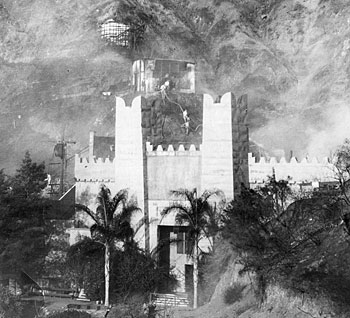
The original Ford was destroyed in this October 24, 1929 brushfire. Photo/Herald Examiner Collection, L.A. Public Library
In addition, with $28.5 million in additional funding recently approved as part of the county’s supplemental budget, the scope of the construction has broadened to include soundwalls to buffer the noise from the 101 Freeway, an expansive terrace where up to 200 people can enjoy pre-concert picnics, and a two-level structure with a new concession area on the first floor and offices for the Ford staff above.
“By combining the previously approved work with the new projects, we will be able to save several millions of dollars in construction costs,” said Laura Zucker, executive director of the Los Angeles County Arts Commission, which operates the Ford.
The current work—including earlier phases that involved developing the master plan and environmental impact report, replacing the amphitheatre’s seats and stripping away yellow paint to reveal its original concrete surface—has a total price tag of nearly $56.6 million.
Still to come in future years, once funding is identified, are a transportation plaza with a three-level parking garage, a restaurant, a 299-seat theatre and a ¾ mile-long hiking trail with majestic views of the Hollywood sign and other vistas.
Beyond new amenities, the work will address some longstanding problems that have plagued the 1,200-seat amphitheatre.
“It’s literally had mudslides going through it,” said Adam Davis, the Ford’s managing director of productions. “It’s kind of been neglected and this project is really going to help.”
The project’s architect, Brenda Levin, whose historic preservation work includes acclaimed projects at the Griffith Observatory, Wilshire Boulevard Temple and Dodger Stadium, said it is impossible to separate the Ford from its unique natural setting on county parkland in the Cahuenga Pass.
“The building itself is set deep into a canyon, and the canyon is very much part of the theatrical experience,” Levin said. “At the Ford you’re focused on the natural landscape, which will be maintained.”
By the time all the work described in the master plan is concluded, the public is likely to see the Ford and its surroundings in a dramatically different light, she said.
“I don’t think at this point that many people would describe the Ford as sitting in the middle of a 32-acre park,” Levin said. “I do think after this project is complete, they will totally understand that.”
Supervisor Zev Yaroslavsky, a longtime backer of the facility since he was elected to the county Board of Supervisors in 1994, said the coming work will be a game-changer for the Ford. “During my tenure we have continually made incremental improvements, but this really takes it to the next level,” he said. Yaroslavsky, who is retiring from the Board of Supervisors later this year, predicted that when the amphitheatre reopens in the summer of 2016, patrons will be in for their “best-ever Ford Theatres experience.”
Over the past two decades, the Ford has forged a unique identity among Los Angeles concert venues through its “partnership program” showcasing local artists, and more recently with its annual “Zev Yaroslavsky Signature Series” that aims to draw new audiences with programming pairing nationally known performers with homegrown talent.
With the Ford closing for construction next summer, plans are underway to bring a series of performances into various communities around the county.
Posted 10/8/14
A big legacy, no bones about it
September 15, 2014
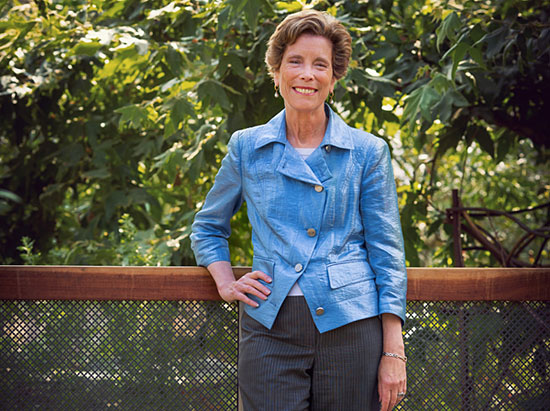
Pisano in the county museum's nature gardens, where she loves to walk. "The big bonus is those gardens used to be parking lots," she says. Photo/Christina Gandolfo
Over the past 13 years, Jane Pisano has presided over a dramatic transformation of the county’s venerable Natural History Museum.
Huge emblems of her accomplishments are visible all over the museum, from the striking glass entry pavilion featuring a suspended 65-foot fin whale to the trio of fearsome young T. rexes showcased in the new Dinosaur Hall.
But those show-stoppers don’t tell the whole story of the NHM as reimagined on Pisano’s watch.
With her recent announcement that she will be retiring from her post once a successor is named, it’s time to take a spin through some of the exhibits and artifacts—large and small—that have meant the most to Pisano over the years.
Here are a few of her favorite things—from a buzzed about “hotel” in the museum’s gardens to a stained glass window with a trans-generational backstory.
A really big sea lion
“There are parts of this museum that I just love because my grandchildren love ‘em,” Pisano says—like the dioramas. “My favorite is an enormous sea lion that is in the North American Mammal Hall and I’ve never seen one as big in nature but he looks like he could be almost anywhere on the California coast, preening and proud and clearly the biggest one around. I love the California coast so this one has special appeal to me.”
All that glitters
“I love the gold exhibit in the Gem Hall because it tells this wonderful story of California gold and the Gold Rush. You can kind of lose yourself in the abundance of it. And the story is so compelling. Almost all that gold, if not all of it, comes from California mines.”
The case of the pregnant plesiosaur
This fossil, between 72 million and 78 million years old and now residing in the museum’s Dinosaur Hall, “encapsulates in one object all of the things that we do here,” Pisano says. Not only does the fossil showcase groundbreaking findings by museum scientists but it also comes with some gee-whiz factoids. (Who knew that newborn plesiosaurs came into the world at 40% of the mother’s size?)
A whale of an early mammal
This 52-million-year-old Pakicetus skeleton in the Age of Mammals exhibit, which is seen on the left above, is—believe it or not—“a close relative of the modern whale,” Pisano says. The creature probably spent a lot of its time in the water, like the hippo. “It really shows that the early mammals, after the age of dinosaurs, adapted in search of food.”
The bee hotel
“I love, love walking in the garden and one of my favorite places to check is the Bee Hotel. You think you know about nature because it’s all around us, but when you go to the nature gardens, you just look and you see in a new and different way.”
Grandson to the rescue
When the 101-year-old museum was undergoing renovation, the stained glass window that crowns the Haaga Family Rotunda was showing signs of its age. “We built a platform there, and the grandson of the guy who designed and installed that window came and cleaned it and fixed it, reconnected it in places where gravity was really jeopardizing the glass. I never look at that without thinking about the whole process of saving it and preserving it.”
Where kids turn into scientists
“I love everything in the Nature Lab. One of my very favorite things is to walk through the Nature Lab in the middle of the day and see the children gathered around the table where our scientists are working, engaged and interested and asking questions about what they’re doing. I love that.”
Posted 9/15/14
Rhapsody in blue
September 10, 2014
It was the kind of discovery that can rock a gem scientist’s world.
Eloïse Gaillou, an associate curator at the Los Angeles County Natural History Museum, started picking up social media chatter early this year about a 29.6 carat rough diamond found in South Africa.
She hardly imagined that just months later she would be on a team at the Smithsonian Institution conducting scientific tests on the rare diamond—now exquisitely cut to 12 carats and dubbed the Blue Moon for its exceptional color—let alone helping to host the super-stone’s visit to Los Angeles, where it will be on display in the museum’s gem vault from September 13 through January 6.
“We tweeted about it, we blogged about it, never thinking that it would come to us eventually,” Gaillou said.
The Blue Moon will join a collection of 240 colored diamonds called the “Aurora Butterfly of Peace” now on display at the museum.
“Putting those two collections together is really going to be an exceptional thing for the public to see. You won’t be able to see that many colored diamonds again in your life,” Gaillou said. “I’m sure we’re going to blow people’s minds.”
The idea for the temporary exhibition was launched, she said, after the owner of the Butterfly of Peace diamonds put her in touch with Cora International, the diamond firm that owns the Blue Moon. Cora International agreed to allow the museum to display the rare stone, whose distinctive color comes from traces of boron within its carbon structure.
It is likely to be the only public display of the diamond before it disappears discreetly into a private collection, Gaillou said.
Gaillou, who grew up in the Brittany region of France, has childhood memories of prospecting for fossils and minerals in local fields and on vacations with her parents in the Alps. As a geologist specializing in gemstones, she focused on sapphires for her master’s degree and opals for her doctorate, but became interested in diamonds when she pursued a diploma in gemology. It was at the Smithsonian, where she did nearly five years of post-doctoral work before joining the county’s Natural History Museum in 2012, that she began to turn her attention to rare pink and blue diamonds—“the ones that you don’t usually have the opportunity to study unless you are in a very special place that owns such diamonds.”
Even without glamorous visitors like the Blue Moon and the Butterfly of Peace passing through, Gaillou said the NHM’s gem collection is “amazing,” second only to the Smithsonian’s.
While she got a thrill from handling the Blue Moon during the scientific tests with her former colleagues at the Smithsonian last month, it’s clear that science—not jewelry—is this curator’s best friend.
She was most wowed by the Blue Moon’s red afterglow—“a good 20 seconds!”—after it was exposed to UV light. That kind of phosphorescence, she said, is usually associated only with the finest blue diamonds, like the Hope and the Wittelsbach-Graff.
“Diamonds, they’re pretty, don’t get me wrong. But from a scientific point of view, I just love studying diamonds. They give us a clue not only about the deep earth, but also the evolution of the earth from about 3 billion years ago until now,” she said. “You would be done looking at a diamond in about five minutes if you were just looking at its aesthetics. But from the scientific point of view, I have been working on them for over seven years now.”
Still, like a pastry chef who steers clear of macarons, Gaillou said she doesn’t indulge much in sparkling bijoux in her private life.
“I see so many beautiful things that I don’t even buy jewelry myself, or not much. I think it has probably killed it for me,” she laughed.
But she does get a charge out of walking through the museum’s gem exhibits on the way to her office each day, and overhearing the oohs and aahs from visitors.
She’s expecting to get quite an earful in the months ahead. Even though she has studied more than 100 diamonds, including legendary stones like the Hope, the Wittelsbach-Graff and the Blue Heart, she considers the Blue Moon exceptional.
“You never get tired of looking at big gems like that,” said Gaillou, 34. “There’s just something about this color. It’s something that you will never forget.”
“Some gemstones are just dead, and some gemstones are just alive. And definitely this one is alive. You see it. It’s just aglow. The cut is wonderful, the fire is amazing. After that, as to the personality of the Blue Moon, I think that everybody will have a different answer. You just have to come and see the diamond by yourself and make up your mind on that.”
Posted 9/4/14
Opera’s beach blanket bravura
August 27, 2014
It’s not every day that the sublime vocal talents of Plácido Domingo share a place in the sun with funnel cakes, caricature artists and an iconic ocean-front Ferris wheel.
But the tourist-friendly charms of the Santa Monica Pier will be meeting the glories of opera at its grandest when LA Opera brings its first-ever free live simulcast to the beach on Wednesday, September 17.
The high-definition broadcast of Verdi’s “La Traviata,” beamed live via satellite from the stage of the county Music Center’s Dorothy Chandler Pavilion to a giant screen on the pier’s wooden parking deck, ushers in a new tradition for the company, which plans to offer the program every other year.
“If I weren’t in the cast for this production, I’d want to be in the audience myself!” Domingo, the opera’s general director, said in a news release announcing “Opera at the Beach.”
Domingo is scheduled to sing the role of Giorgio Germont in a production that also includes soprano Nino Machaidze (as Violetta Valéry) and tenor Arturo Chacón-Cruz (as Alfredo Germont), with LA Opera music director James Conlon conducting.
“La Traviata” tells the story of a glamorous courtesan and her doomed love affair; NPR once dubbed it “the original Pretty Woman.” It opens LA Opera’s 2014-15 season on Saturday, September 13, with the beach simulcast taking place at 7:30 p.m. the following Wednesday.
For the production team, turning a day at the beach into a night at the opera has had as many complications as the most byzantine libretto.
“It’s been a big challenge. There are other opera companies that routinely do simulcasts, and we’re not one of them. For us this is the first time,” said Rupert Hemmings, the opera’s senior director of production. “The off-site logistics involved with setting up the pier and getting all of the equipment at that end and then of course the actual transfer of the product by satellite—all of that is new to us. It has been a steep learning curve, but I think we have everything in place for a success.”
The 21-by-40-foot screen, elevated on a six-foot-high platform, will be angled toward the ocean at the end of the pier’s parking deck. Folding chairs and blankets are recommended for spectators, who will be sitting on the deck’s rough-hewn wood beams, as they do for Santa Monica’s popular Twilight Concerts series. Although there is no charge for admission, the opera strongly encourages those who wish to attend to pre-order tickets online. (There’s a $1 handling fee for each order of up to 8 tickets.)
No alcoholic beverages are allowed, but there will be a designated beer garden. And while the simulcast is free, parking isn’t—so be prepared and perhaps consider reserving a space in advance.
The opera, underwritten with funds made available by Supervisor Zev Yaroslavsky, will be sung in Italian, with English translations superimposed on the screen during the simulcast.
With the advent of “Opera at the Beach,” L.A. joins a number of other cities where simulcasts have become a popular part of the cultural fabric, including San Francisco’s “Opera at the Ballpark” at AT&T Park and Washington, D.C.’s “Opera in the Outfield” at Nationals Park.
Whatever the locale, the name of the game is enticing new audiences to sample the art form, risk-free, while enjoying a communal event at a local landmark.
“I think that opera can be seen as elitist,” the opera’s Hemmings said. “I don’t feel it is, having been in it for most of my life, but I think when people can get out there and see this kind of thing for free—and see how much fun it is, and how emotionally stimulating it can be—that’s fantastic.”
LA Opera’s simulcast of “La Traviata” starts at 7:30 p.m. on Wednesday, September 17, at the Santa Monica Pier. Free tickets are available here, and directions and parking information are here.
Posted 8/27/14
This film could rock your world
August 13, 2014
Some movies launch with advertisements screaming from broadcasts, buses and billboards.
“Levitated Mass”— a documentary about the amazing journey of a 340-ton boulder into the hearts, minds and artistic consciousness of Southern California—is not one of those movies.
Although it tells a big, sprawling story about culture, community, bureaucratic challenges and engineering ingenuity, the documentary is going for more of a micro-targeted approach when it comes to publicizing its upcoming theatrical release.
As in: taking to the streets and putting up posters at points along the 105-mile-long “rock route” where large crowds gathered as the boulder slowly made its way to the Los Angeles County Museum of Art in March, 2012.
By heading out to those neighborhoods with bright yellow posters reading “Remember when the rock rolled?” director Doug Pray is hoping to reunite some of the diverse characters who witnessed its epic journey from a Riverside County quarry to LACMA, where it now forms part of a monumental sculpture that has been visited by more than 600,000 people. (When the sculpture first was unveiled, 6,000 visitors flocked to the museum, setting an opening-day attendance record. It also sparked voluminous coverage, including this video on Supervisor Yaroslavsky’s website.)
Pray’s documentary, which premiered at the L.A. Film Festival last year, begins its theatrical release on Sept. 5 with a one-week run at the Nuart Theatre before moving on to play a number of other cities this fall. The documentary is one part art film focusing on the work of sculptor Michael Heizer, one part road movie, and one part behind-the-scenes docudrama about how the rock rolled (and almost didn’t.)
Some of its best moments come in interviews with people from all walks of life who weigh in on what to make of the new behemoth on the block. (The movie trailer offers a taste of their critiques.)
One woman theorizes that the massive white-wrapped object is not really a boulder at all but rather a suspicious giant artifact left over from a secret military base.
Some of those lining the streets see a colossal waste of money (though the $10 million project was privately financed) while others experience genius at work. Some detect the hand of God, and others glimpse a parable for all of life’s journeys.
Throughout, the film captures the sense of a slo-mo happening-in-progress that people across the Southland felt free to experience—sometimes right in their own front yards.
As one young girl put it: “Nothing really happens on this street, and now something amazing just happened.”
Beyond its chronicle of those who watched the rock roll through three counties and 22 diverse communities over the course of 10 days and nights, the film also offers some unusual inside footage: computer simulations of how the boulder would fare in an earthquake, artist Heizer interacting with workers installing the massive stone atop a concrete trench at LACMA, interviews with art world elites and donors, government officials grappling with seemingly impossible logistics, and some reality TV-style moments showing what happens when a transport truck’s transmission suddenly seizes up mid-voyage. (Spoiler alert: they figure out a way to get to a happy ending.)
Then there’s the boulder itself, which filmmaker Pray is only a little sheepish about dubbing a “rock star.”
“It’s as close as I’ve ever come to making an inanimate object into a character,” Pray said. “Because it kind of grows on you. It does have personality…It definitely became its own pop culture phenomenon. The whole joke of ‘the rock became a star,’ it’s a silly pun but the truth is it literally did.”
And, as big as the rock is, the film makes clear that it also fostered something even larger: a sense of community across our sprawling Southern California landscape.
“From wealthy neighborhoods to poor neighborhoods, from Riverside to Long Beach to downtown L.A.,” Pray said, “it was like the boulder itself kind of made this into a portrait of L.A.”
Posted 8/13/14
Art is the next big thing
July 24, 2014
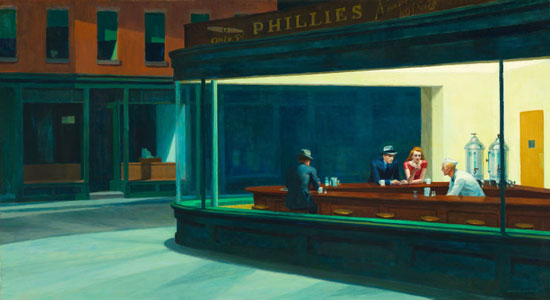
"Nighthawks," from the collection of the Art Institute of Chicago, will be seen in L.A. and nationwide.
Edward Hopper’s moody “Nighthawks” will be having their after-hours cups of java on a wall in San Francisco—and at 18 feet high by 50 feet wide, they’ll be hard to miss.
Grant Wood’s dour duo from “American Gothic” will be living large on the staircase of New York’s Port Authority.
And here in L.A., rush hour traffic will be getting a jolt of cultural uplift as buses rumble by wrapped in iconic works like Ed Ruscha’s “Hollywood.”
Just like millions of vacationers, American art is hitting the road this summer.
Starting August 4, 58 masterpieces will be breaking out of five major museums and onto the streets. The exhibition, called Art Everywhere US, is modeled after a similar show in the United Kingdom and is intended to create what the organizers call a “free, open-air art gallery across the country” throughout the month of August.
The featured reproductions include 11 pieces from the Los Angeles County Museum of Art. Among them: Andy Warhol’s “Campbell’s Soup Can,” Roy Lichtenstein’s “Cold Shoulder,” Willem de Kooning’s “Montauk Highway” and Mark Rothko’s “White Center.”
But L.A.’s al fresco gallery won’t be limited to the LACMA works; all 58 of the featured pieces will be on display here at some 500 locations around town. Exact locations will be announced soon on the project’s website, where an interactive map will make spotting the masterpieces easy. There also will be an Instagram contest for people to show off selfies they’ve taken with the oversized artworks.
In addition to the wrapped buses, “the digital billboards in L.A. will be featuring the art works,” said Stephen J. Freitas, chief marketing officer of the Outdoor Advertising Association of America, which is collaborating on the project with LACMA, the Art Institute of Chicago, the National Gallery, the Whitney and the Dallas Museum of Art. “We’ve got a wonderful Warhol that’s going to be coming your way on a lot of bus shelters.”
Nationwide, the art is being displayed in all 50 states on donated billboard and other advertising space valued at tens of millions of dollars, Freitas said. The effort started with 100 works of art suggested by the museums; members of the public then had a chance to vote on their favorites to winnow down the list to the final 58.
Taken together, the pieces represent a kind of American Art 101—from Gilbert Stuart’s portrait of George Washington to Robert Mapplethorpe’s portrait of “Ken Moody and Robert Sherman.”
“It’s a great opportunity not only for LACMA to represent Los Angeles, but to show its history through a painting like Millard Sheets’ ‘Angel’s Flight,’ or Ed Ruscha’s depiction of the Hollywood sign,” said Michael Govan, LACMA’s director and CEO.
And you don’t need to be an art history major to enjoy it.
“We’re hoping this campaign will help drive more interest in American art and drive people to more American museums to see art in person. But we also think it’s a great way to just give people a lift in their day, give them something unexpected on their way to work or traveling down the road,” Freitas said. “We think it will inspire a little happiness in American life, we hope, for a few days or a few moments.”
Posted 7/24/14
Magic in the muck
June 19, 2014
John Harris loves the smell of asphalt in the morning. As chief curator of the county’s Page Museum at the La Brea Tar Pits, he’s been enjoying the pungent smell since 1980. “I open the door of the car, and I’m here,” he said, demonstrating his appreciation with a dreamy sniff.
Not everyone shares his olfactory pleasure. “It sure smells,” observed a little boy in a baggy yellow T-shirt as he checked out some of the famous black ooze before heading into the museum with his family.
Individual noses notwithstanding, there’s a sweet smell of progress around the iconic tar pits these days. The famous mammoth and mastodon statues by the bubbling lake bed have been spiffed up and, more significantly, two scientific hot spots on the museum campus have been reactivated so that the public can get a sense of the discoveries being made each day right beside busy Wilshire Boulevard.
Beginning June 28, the mid-century Observation Pit—a repository for large Ice Age fossils from throughout the tar pit area—will become a highlight of the museum’s new Excavator Tour, after being closed since the mid-1990s. At the same time, Pit 91 is now open for excavation and public viewing after a seven-year hiatus.
The re-opened sites promise to be tourist attractions, educational resources and must-see stops on any fossil geek’s itinerary. They also mean new jobs. The museum has hired two new excavators for Pit 91. In addition, two new gallery interpreters will lead tours and five new guest relations staffers have been added.
Museum officials said the Observation Pit was closed for many years to allow excavators to concentrate their attention on the very productive Pit 91, site of such key finds as the first confirmed piece of a very young mammoth. But the excavation of Pit 91 eventually ceased because of another treasure trove of fossils uncovered in 2006 during construction of the Los Angeles County Museum of Art’s subterranean parking lot. Page Museum officials decided to focus excavation resources on the new finds, the most renowned of which was a mammoth nicknamed Zed. That ongoing effort is named Project 23 after the number of crates of specimens uncovered there.
Re-opening the Observation Pit and Pit 91 seemed like a good way to give visitors a different vantage point for exploring the museum’s collection, said Jane Pisano, president and director of the Natural History Museum of Los Angeles County, which oversees the Page.
“We have a very exciting opportunity here to preserve the tar pits for present and future scientific discoveries and at the same time do a much better job for our visitors connecting the work outside with what’s on display inside the Page Museum,” Pisano said.
She added that the new exhibits offer a window into the latest scientific thinking on what fossils can teach us. The bottom line: size matters. Smaller is better for examining changes in the environment, including climate change. While it may be sexier to find a big cat or mastodon, “the reason to focus on the smaller fossils is that those critters lived here year round,” Pisano said. “We know the bison and larger animals were migrating and only came here once in a while.”
As chief curator Harris put it: “The real emphasis now is not on the big fossils, because we’ve learned pretty much what we can. Now it’s the smaller fossils and what they can tell us.”
Officials unveiled the new attractions today. Supervisor Zev Yaroslavsky said it’s all part of a virtuous cycle of education and inspiration.
“The more access that people have to the tar pits, the more their curiosity gets piqued. The more their curiosity gets piqued, the better our quality of life is. And one or two of those kids who come here may become scientists who ultimately work for the Natural History Museum, analyzing what’s found underneath these properties,” Yaroslavsky said.
The reactivated exhibits at the tar pits are part of a Miracle Mile boom that includes extending the Purple Line subway and creating a new building at the Los Angeles County Museum of Art, to be designed by renowned architect Peter Zumthor.
“This part of Los Angeles…is on a roll,” Yaroslavsky said. “We are very excited about the future as much as we are curious about the past.”
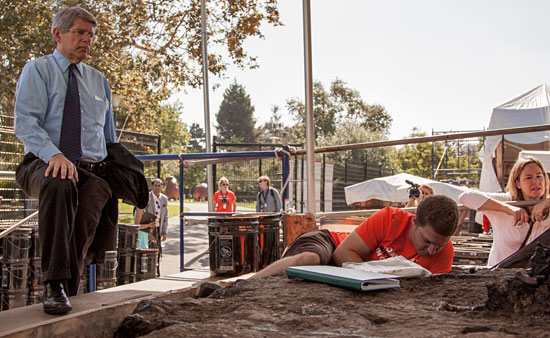
Yaroslavsky checks out some of the fossil excavation efforts taking place on the grounds of the tar pits.
Posted 6/19/14





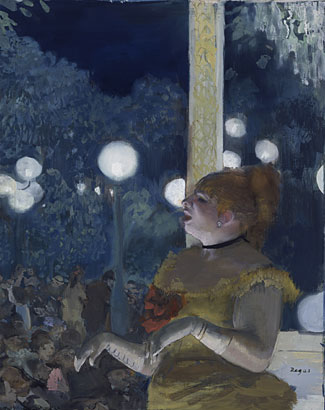
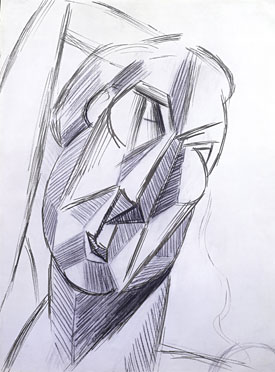
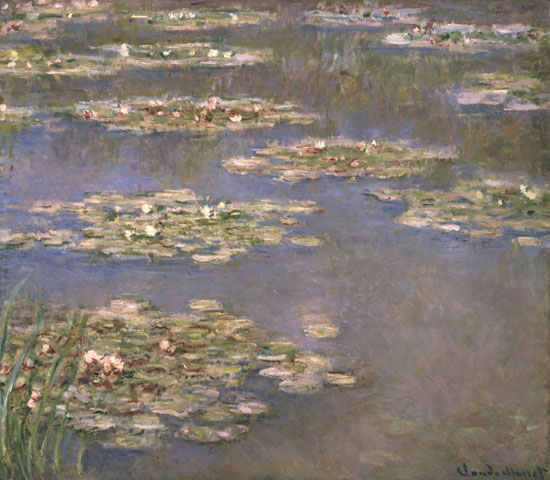
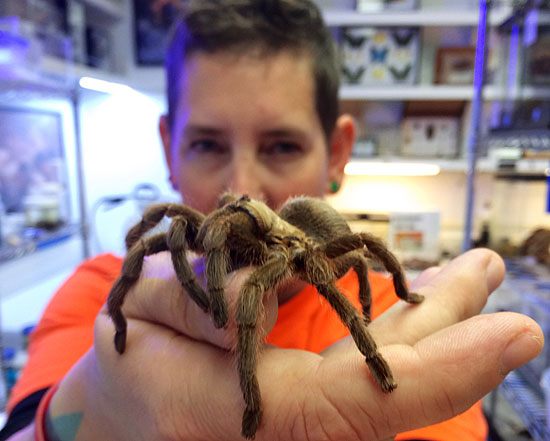
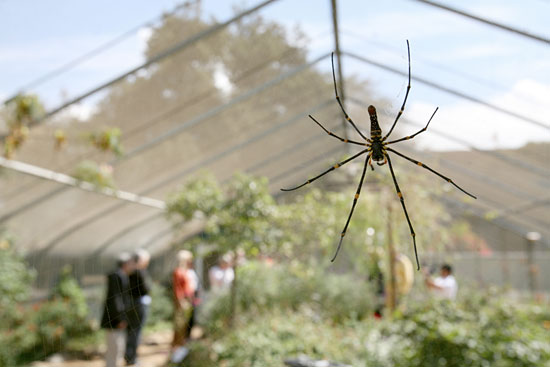

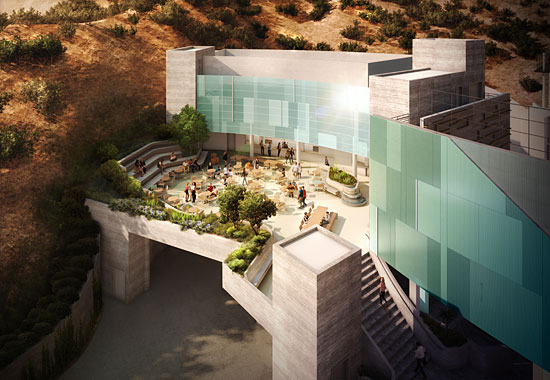
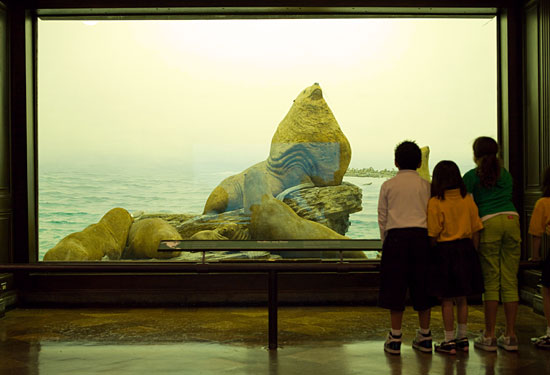
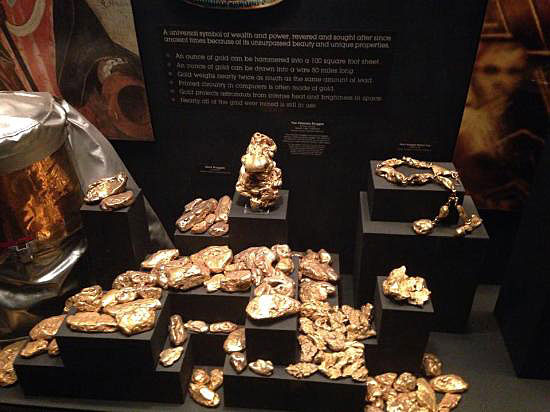
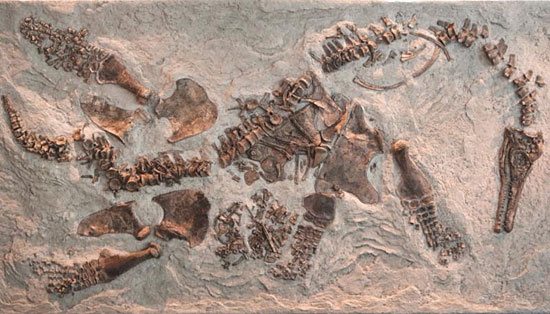
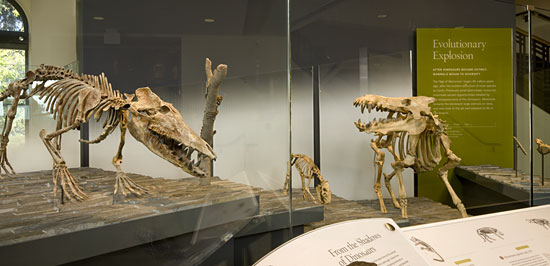
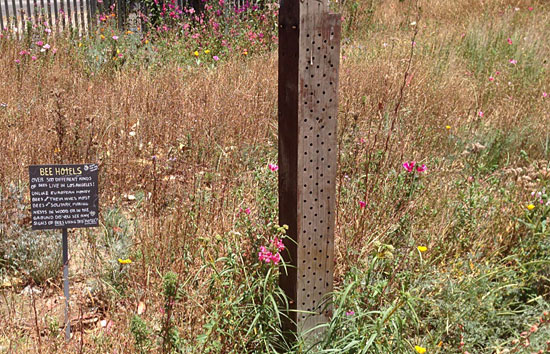
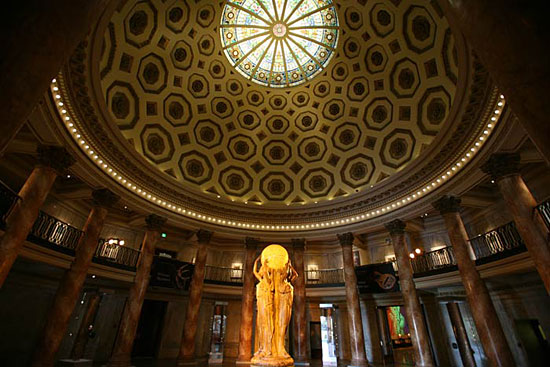
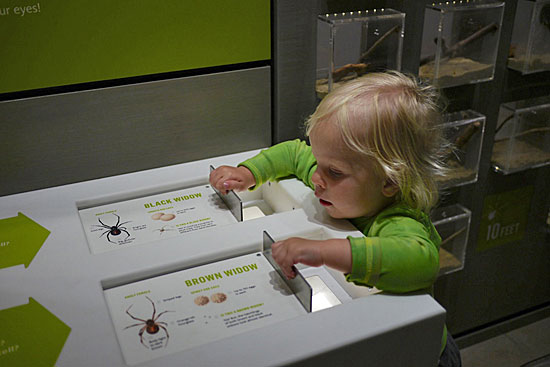
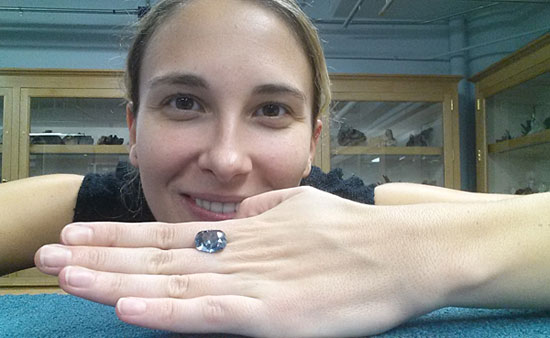


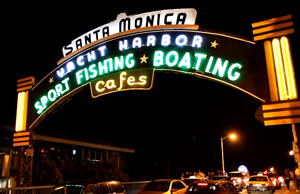
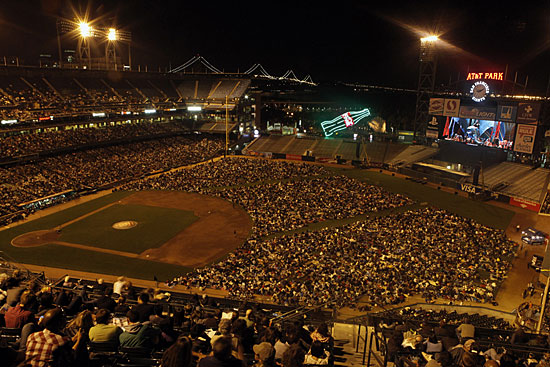


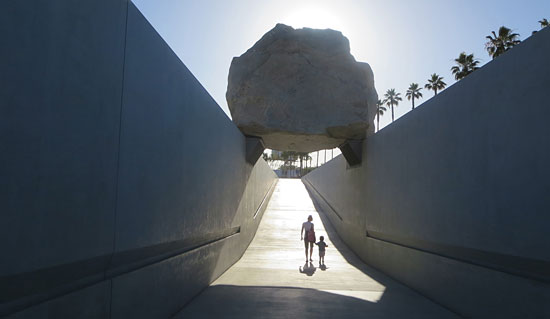

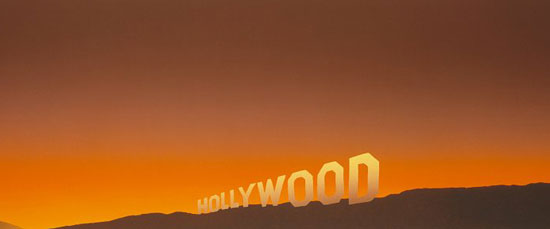
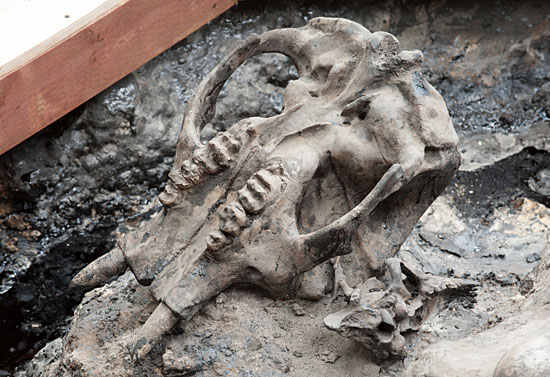









 405 bridge work causes a stink
405 bridge work causes a stink